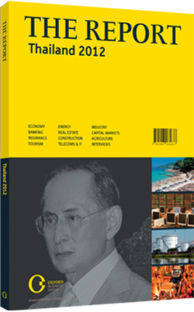Bangkok Bank: Banking
THE COMPANY: Established in 1944, Bangkok Bank (BBL) is the largest commercial bank in Thailand and the seventh-largest regional bank in South-east Asia. It had total assets of roughly $69bn as of March 2012 and is Thailand's market leader in the corporate segment with the largest retail customer base in the country. BBL has 17m accounts, including business and retail customers, over 230 business centres and business desks, and a nationwide network of nearly 1000 branches, with more than 7500 ATMs.
BBL has the largest overseas branch network compared to any Thai bank and is the only one that has a substantial presence in China, with branches currently in Beijing, Shanghai, Xiamen and Shenzhen. It has branch networks in 13 countries: China, Hong Kong, the US, the UK, Japan, Taiwan, Singapore, the Philippines, Malaysia, Vietnam, Indonesia, Laos and Myanmar. In total, BBL has 15 overseas branches, one representative office and two wholly owned subsidiaries: Bangkok Bank Berhad and Bangkok Bank China.
BBL is also moving towards a universal banking platform, offering full commercial banking services, which includes arranging syndicated loans, debt securities underwriting, trade finance, project finance, custodial services, small and medium-sized enterprise (SME) and merchant services and specialist industry advice. Subsidiaries such as Bualuang Asset Management and Bualuang Securities also enable the bank to develop investment opportunities that are available exclusively to BBL customers. Regarding total loans, 47% is issued to corporates, 26% to SMEs, 10% retail and 17% overseas and others. Fee-based income stood at 30% of total income as of the first quarter of 2012.
BBL also has superior asset quality, with a low 2.6% non-performing loan (NPL) ratio. It has also adopted a pre-emptive provisioning policy. Therefore, despite having NPLs well under control, the bank continuously sets aside provisions. BBL’s loan loss coverage ratio of 193% is one of the highest in the sector, and the bank had a decent capital adequacy ratio of 16% as of March 2012.
DEVELOPMENT STRATEGY: BBL’s key competitive strengths lie with its customer base – the largest in Thailand – its well-established relationships with corporate clients and its regional branch network. The bank’s strategy will be to continue to deploy and leverage these strengths. BBL is also planning to build on the synergies between its strategic business units and subsidiaries in order to expand its range of services and further strengthen its fee income base. In addition, BBL plans to develop further its presence overseas, particularly in China and Malaysia.
Some 54% of BBL’s loans are from the manufacturing sector, which was hit hardest by the 2011 floods. While the floods did not do much harm to the bank’s asset quality, as most of its customers are financially sound large firms, BBL looks set to benefit the most from post-flood repair activity and economic recovery momentum. The bank said it has seen rising loan applications for machinery and equipment imports. This, together with a resumption of capex loans, was driving its loan momentum by 3% quarter-on-quarter in the first quarter of 2012, and it could grow 13% in 2012.
BBL’s exposure to bills of exchange (B/E) is among the lowest, at 4% of total funding, so the government’s move to levy Financial Institutions Development Fund fees on outstanding B/E would not create a huge burden on its funding costs and spread.
BBL’s net interest margin should contract by 0.9%, and will largely be offset by rising loan volume. BBL set aside hefty extra provisions in the final quarter of 2011, pushing up total provisioning expenses to BT12bn ($382.8m) and raising its loan loss coverage ratio to 200%. As the move was mainly to exploit tax benefits, and with limited NPL risks due to healthy economic recovery, BBL is looking to cut provisions to BT6bn-7bn ($191.4m-223.3m). With a sharp provisions cut, robust loan growth and a decent loan chain reaction, there should be stronger earnings growth of 24.3% in 2012 and 14.4% in 2013. Return on equity should also expand by 1.8% to 13% in 2012, increasing to 14% in 2013.
You have reached the limit of premium articles you can view for free.
Choose from the options below to purchase print or digital editions of our Reports. You can also purchase a website subscription giving you unlimited access to all of our Reports online for 12 months.
If you have already purchased this Report or have a website subscription, please login to continue.

